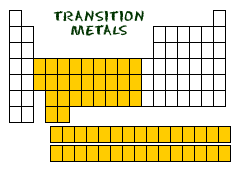Let's learn some characteristics of each group:
1. Alkali Metals:
Group
1
—Hydrogen is not a
member, it is a non-metal
—1 electron in the outer shell
—Soft and silvery metals
—Very
reactive with water
—Conduct electricity
2. Alkaline Earth Metals:
Group
2
—2 electrons in the outer shell
—White and malleable
—Reactive, but less than Alkali metals
—Conduct electricity
3. Boron Family:
Group
3 0r 13
—3 electrons in the outer shell
—Most are metals
—Boron is a metalloid
4. Carbon Family:
Group
4 or 14
—4 electrons in the outer shell
—Contains metals, metalloids, and a non-metal
Carbon (C)
5. Nitrogen Family:
Group
5 or 15
—5 electrons in the outer shell
—Can share electrons to form compounds
—Contains metals, metalloids, and non-metals
6. Oxygen Family:
Group
6 or 16
—6 electrons in the outer shell
—Contains metals, metalloids, and non-metals
—Reactive
7. Halogens:
Group
7 or 17
—7 electrons in the outer shell
—All are non-metals
—Very reactive are
often bonded with elements from Group 1
8. Noble gases:
Group
8 or 18
—Exist
as gases
—Non-metals
—8
electrons in the outer shell = Full
—Helium
(He) has only 2 electrons in the outer shell = Full
—Not
reactive with other elements
Group of Transition metals and Group of Rare earth
Groups
in the middle
—Good
conductors of heat and electricity.
—Some
are used for jewelry.
—The
transition metals are able to put up to 32 electrons in their second to last
shell.
—Can
bond with many elements in a variety of shapes.
The last two rows are the Rare earth metals the first is called Lanthanides and the second is called Antinides.
Some
are Radioactive
—The
rare earths are silver, silvery-white, or gray metals.
—Conduct
electricity.

No hay comentarios.:
Publicar un comentario